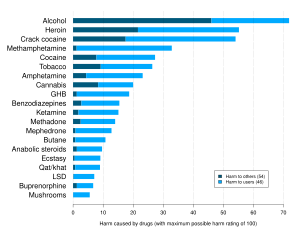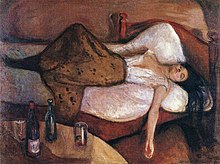In psychology, libido is psychic drive or energy, usually conceived as sexual in nature, but sometimes conceived as including other forms of desire. The term libido was originally used by the neurologist and pioneering psychoanalyst Sigmund Freud who began by employing it simply to denote sexual desire. Over time it came to signify the psychic energy of the sexual drive, and became a vital concept in psychoanalytic theory. Freud's later conception was broadened to include the fundamental energy of all expressions of love, pleasure, and self-preservation.
An aphrodisiac is a substance alleged to increase libido, sexual desire, sexual attraction, sexual pleasure, or sexual behavior. These substances range from a variety of plants, spices and foods to synthetic chemicals. Natural aphrodisiacs like cannabis or cocaine are classified into plant-based and non-plant-based substances. Synthetic aphrodisiacs include MDMA and methamphetamine. Aphrodisiacs can be classified by their type of effects. Aphrodisiacs that contain hallucinogenic properties like bufotenin have psychological effects on a person that can increase sexual desire and sexual pleasure. Aphrodisiacs that have smooth muscle relaxing properties like yohimbine have physiological effects on a person that can affect hormone levels and increase blood flow.

Alcohol abuse encompasses a spectrum of alcohol-related substance abuse, ranging from the consumption of more than 2 drinks per day on average for men, or more than 1 drink per day on average for women, to binge drinking or alcohol use disorder.
Sexual dysfunction is difficulty experienced by an individual or partners during any stage of normal sexual activity, including physical pleasure, desire, preference, arousal, or orgasm. The World Health Organization defines sexual dysfunction as a "person's inability to participate in a sexual relationship as they would wish". This definition is broad and is subject to many interpretations. A diagnosis of sexual dysfunction under the DSM-5 requires a person to feel extreme distress and interpersonal strain for a minimum of six months. Sexual dysfunction can have a profound impact on an individual's perceived quality of sexual life. The term sexual disorder may not only refer to physical sexual dysfunction, but to paraphilias as well; this is sometimes termed disorder of sexual preference.
A date rape drug is any drug that incapacitates another person and renders that person vulnerable to sexual assault, including rape. The substances are associated with date rape because of reported incidents of their use in the context of two people dating, during which the victim is sexually assaulted or raped or suffers other harm. However, substances have also been exploited during retreats, for example ayahuasca retreats. The substances are not exclusively used to perpetrate sexual assault or rape, but are the properties or side-effects of substances normally used for legitimate medical purposes. One of the most common incapacitating agents for date rape is alcohol, administered either surreptitiously or consumed voluntarily, rendering the victim unable to make informed decisions or give consent.
An anaphrodisiac is a substance that quells or blunts the libido. It is the opposite of an aphrodisiac, something that enhances sexual appetite. The word anaphrodisiac comes from the Greek privative prefix ἀν-, denoting negation, and aphrodisiac, from the Greek goddess of love, Aphrodite. Some people use anaphrodisiacs in order to curb a very high libido or due to hypersexuality. However anaphrodisiacs are also used by those with an average libido, at times due to having incessant schedules.
Alcohol has a number of effects on health. Short-term effects of alcohol consumption include intoxication and dehydration. Long-term effects of alcohol include changes in the metabolism of the liver and brain, several types of cancer and alcohol use disorder. Alcohol intoxication affects the brain, causing slurred speech, clumsiness, and delayed reflexes. There is an increased risk of developing an alcohol use disorder for teenagers while their brain is still developing. Adolescents who drink have a higher probability of injury including death.
Sex and drugs date back to ancient humans and have been interlocked throughout human history. Both legal and illegal, the consumption of drugs and their effects on the human body encompasses all aspects of sex, including desire, performance, pleasure, conception, gestation, and disease.
Rape is a traumatic experience that affects the victim (survivor) in a physical, psychological, and sociological way. Even though the effects and aftermath of rape differ among victims, individuals tend to suffer from similar issues found within these three categories. Long-term reactions may involve the development of coping mechanisms that will either benefit the victim, such as social support, or inhibit their recovery. Seeking support and professional resources may assist the victim in numerous ways.
The sexuality of US adolescents includes their feelings, behaviors and development, and the place adolescent sexuality has in American society, including the response of the government, educators, parents, and other interested groups.
Alcohol myopia is a cognitive-physiological theory on alcohol use disorder in which many of alcohol's social and stress-reducing effects, which may underlie its addictive capacity, are explained as a consequence of alcohol's narrowing of perceptual and cognitive functioning. The alcohol myopia model posits that rather than disinhibit, alcohol produces a myopia effect that causes users to pay more attention to salient environmental cues and less attention to less salient cues. Therefore, alcohol's myopic effects cause intoxicated people to respond almost exclusively to their immediate environment. This "nearsightedness" limits their ability to consider future consequences of their actions as well as regulate their reactive impulses.

Binge drinking, or heavy episodic drinking, is drinking alcoholic beverages with an intention of becoming intoxicated by heavy consumption of alcohol over a short period of time, but definitions vary considerably.
Campus sexual assault is the sexual assault, including rape, of a student while attending an institution of higher learning, such as a college or university. The victims of such assaults are more likely to be female, but any gender can be victimized. Estimates of sexual assault, which vary based on definitions and methodology, generally find that somewhere between 19–27% of college women and 6–8% of college men are sexually assaulted during their time in college.

A caffeinated alcoholic drink is a drink that contains both alcohol and a significant amount of caffeine. Caffeine, a stimulant, masks some of the depressant effects of alcohol. However, in 2010 and 2011, this type of drink faced criticism for posing health risks to its drinkers. In some places there is a ban on caffeinated alcoholic drinks.

Alcohol-related crime refers to criminal activities that involve alcohol use as well as violations of regulations covering the sale or use of alcohol; in other words, activities violating the alcohol laws. Underage drinking and drunk driving are the most prevalent alcohol‐specific offenses in the United States and a major problem in many, if not most, countries worldwide. Similarly, arrests for alcohol-related crimes constitute a high proportion of all arrests made by police in the U.S. and elsewhere.
Hookup culture is one that accepts and encourages casual sex encounters, including one-night stands and other related activity, without necessarily including emotional intimacy, bonding or a committed relationship. It is generally associated with Western late adolescent sexuality and, in particular, United States college culture. The term hookup has an ambiguous definition because it can indicate kissing or any form of physical sexual activity between sexual partners. The term has been widely used in the U.S. since at least 2000. It has also been called nonrelationship sex, or sex without dating.

Alcohol, sometimes referred to by the chemical name ethanol, is a depressant drug found in fermented beverages such as beer, wine, and distilled spirit — in particular, rectified spirit. Ethanol is colloquially referred to as "alcohol" because it is the most prevalent alcohol in alcoholic beverages, but technically all alcoholic beverages contain several types of psychoactive alcohols, that are categorized as primary, secondary, or tertiary; Primary, and secondary alcohols, are oxidized to aldehydes, and ketones, respectively, while tertiary alcohols are generally resistant to oxidation; Ethanol is a primary alcohol that has unpleasant actions in the body, many of which are mediated by its toxic metabolite acetaldehyde. Less prevalent alcohols found in alcoholic beverages, are secondary, and tertiary alcohols. For example, the tertiary alcohol 2M2B which is up to 50 times more potent than ethanol and found in trace quantities in alcoholic beverages, has been synthesized and used as a designer drug. Alcoholic beverages are sometimes laced with toxic alcohols, such as methanol and isopropyl alcohol. A mild, brief exposure to isopropyl alcohol is unlikely to cause any serious harm, but many methanol poisoning incidents have occurred through history, since methanol is lethal even in small quantities, as little as 10–15 milliliters. Ethanol is used to treat methanol and ethylene glycol toxicity.
Risky sexual behavior is the description of the activity that will increase the probability that a person engaging in sexual activity with another person infected with a sexually transmitted infection will be infected or become unintended pregnant, or make a partner pregnant. It can mean two similar things: the behavior itself, and the description of the partner's behavior.
Marijuana use is commonly thought to enhance sexual pleasure. However, there is limited scientific research on the relationship between marijuana and sex, which is not well understood. The lack of research on the topic is, in part, due to U.S. drug policies centered on prohibition. In addition, the effects are difficult to study because sexual arousal and functioning are in themselves extremely complex and differ among individuals. Moreover, marijuana affects people differently. As a result, it is challenging to study. Men and women report greater sexual pleasure after having consumed marijuana, but there is no direct scientific evidence of the effects on the physiological components of the sexual response cycle when using the drug.

Drugs and sexual consent is a topic that discusses the impacts of drugs on sexual activity that lead to changes in sexual consent. Sexual consent is the voluntary agreement to engage in sexual activity, which is essential in preventing sexual violence. Consent can be communicated verbally or nonverbally and should be freely offered. However, drug use, particularly psychoactive drugs that alter mental processes, can affect people’s decision-making and consent communication ability, potentially impacting the autonomous aspect of sexual consent.









